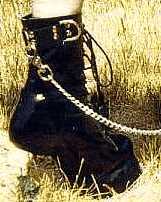
|
|
Look! No heels! The finished hoof boot |
An Illustrated Guide
"Boots" the ponyboy / http://www.cynical.org/boots
Ever since I first saw them a few years ago, I have wanted a pair of the hoof boots offered by the Kayser Novelty Company in Australia. Unfortunately, they are relatively expensive (although the exchange rate from US to Australian dollars is fairly generous), and there are aspects of the design that I find disappointing.
I have had the opportunity to examine a pair owned by my friend Pony Onyx. The most major flaw, in my humble opinion, with his boots is that they are built with a metal outer shell. When he walks in them, they sound buzzy and hollow, not like a real horse's hoof. Call me a snob (I am), but if I'm going to wear hooves, I want them to sound like a horse.
So, I began keeping an eye out for ideas on how to construct a better pair of hooves. A year or so ago, I ran across Starfall's Hooves'R'Us article. He describes how to make a pair of hooves for a person's hands using a type of modeling putty. I read his (excellently written) description and filed the information away in the back of my head.
I usually wear a pair of high-heeled boots with my pony gear (hence my pony name "Boots"), since the shape of the foot is evocative of a horse's hoof. I've been keeping an eye out for a pair of boots that I could build into a hoof, and I finally found one at Pierre Silber, a fetish shoe store in the Bay Area where I work a few hours a week.
The reason I chose this particular boot is that the 2" platform is molded directly into the sole of the shoe, and is hollow. Inside the hollow platform, 1/4"-thick walls create 4 compartments. By cutting away the outer parts of the platform, and drilling holes in it, you create a very strong base which becomes an integral part of the hoof. The soles are made of a very soft thermoplastic which is easy to work with common woodworking tools.

|
|
Angel 6" Sizes 5-14 White/Black |
The next item of business was locating horseshoes. I had decided that I wanted to have a horseshoe on each hoof, for maximum realism. I called around a few local places (look under "Farrier" in the Yellow Pages), and found a farrier who sold me a pair of new size "00" St. Croix horseshoes for $2. They are cast-iron, and were pretty gray and unattractive when I got them. I spent an evening with the bench grinder shining them up. A fine wire wheel, followed by a buffing wheel and jeweler's rouge brought them up to a nice polished finish.
Now that I had the horseshoes, I knew how large the hooves themselves would have to be. I put down a sheet of plastic-coated freezer paper, and drew the outlines of the two horseshoes on it, separated by about 6". Then I placed the right and left boot inside the outline of the horseshoe, and marked where the platform and heel rested. After the measurements, I used masking tape to cover the entire surface of the patent uppers. This protects the uppers from getting clay residue on them.

|
| Equistar diagram of the bottom of a horse's hoof |
Filling in the outline around the platform with clay, build up the basic shape of the hoof directly on the boot. The clay should start at the join between the patent-leather "upper" and the plastic sole of the boot, and extend down to the table, where it follows the shape of the horseshoe. It takes a surprising amount of clay to fill the hooves, especially in the front where the platform is angled away from the horizontal.
Be sure the clay doesn't overlap the patent-leather uppers -- the edges of the uppers will be used to register the molds later, so keep a good clean edge between the sole/hoof and the upper. The hooves can be hung by their laces when you aren't working on them, to avoid deforming the clay models. Setting the clay models on the horseshoes will help you get the shape right. While you have the horseshoes on, check that both heels are raised off the table to the same height. This indicates that the pitch of the finished hooves will be even.
This is the time-consuming step. It took me an entire evening to build up each hoof and get them smooth and shaped correctly. Take your time here -- the final result depends on how carefully the models are constructed. Be sure the two hooves match each other. Also be sure to check that the boots stand straight up and down when viewed from the back. It took me three tries to get the second hoof matching the first and upright.
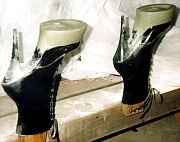
|
| Clay models completely enclosing shoe platforms |
There are a few things I'd like to point out in the picture to the left. First, I cheated. I forgot to take a picture of the virgin models. The picture is of the clay models after I've removed the molds, not immediately after I finished the models. The white discoloration you see is talcum powder used to prevent the latex molds from sticking.
Second, look at the shape of the bottoms of the hooves -- note the raised ring around the edge for the horseshoe, and the "frog" in the center. Also note how the clay completely encloses the shoe's platform sole, but stops right at the junction between the "patent" upper and plastic sole. This is very important, as the molds will be attached to the edges of the upper when they're ready to fill.
It is now time to start making the molds. TAP Plastics sells a product called "Latex Mold Builder", which is a solution of liquid latex that is painted onto the object being molded. It dries to a strong, flexible latex film that can be peeled off like a glove. It is basically the same stuff as is sold in sex shops as liquid latex body paint. I used about 3/4 of a can of the mold builder -- it retails for about $7 a can. Use a regular soft paintbrush to apply the mold builder, and be sure to wash the brush completely with warm water and dishwashing soap after each coat.
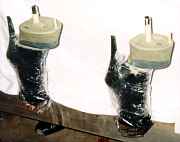
|
| Latex molds showing 3/4" filling tube and small air relief tube |
Wrap the exposed surfaces of the boots with Saran wrap to protect them from drips of the liquid latex. The latex peels easily from the smooth patent surface, but is hard to get out of seams and shoelaces. Trust me on this one. Very gently wipe a very light coat of salad oil or commercial mold release (I happened to have a can of Tek2000 mold release laying around) onto the clay. Be careful not to get it onto the patent uppers, as it will make attaching the finished molds later much more difficult.
Beginning with a thin coat, brush the latex mold builder all over the surface of the clay models, extending it down onto the uppers and around the sole. The edge between the clay/sole and the patent upper will be used later to align the molds with the shoes. Also be sure to put mold builder on the filling and relief tubes. Let the mold builder dry (propping up a small fan to blow air over it helps considerably) until there is no white remaining before putting on the next coat.
One of the big mistakes I made during this project was making the molds too thin. I pulled them off and discovered they were too floppy and thin to use. In the process, I stretched them a little, which made them hard to get back on the shoes later. You can avoid this -- make your molds thick. After the first 3 or 4 coats, mix some fine sawdust into the latex before applying it. I "repaired" my molds by putting them back on the models and coating them with this sawdust/latex mixture.
The sawdust/latex mixture should have a consistency about like a thick milkshake (try it, you'll see). I alternated a "normal" coat with each of three sawdust coats, paying special attention to the top and edges of the hooves around the frog and the ring on which the horseshoe would be placed.
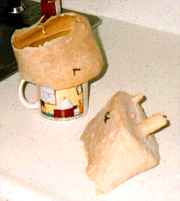
|
| Finished latex molds with markings for left and right hooves |
Once the molds had cured, pull them off the shoes, working from the instep towards the toe. Be sure to dust the molds with talcum powder to prevent them from sticking to themselves when you pull them. Do not use mold release or oils on the outside of the molds -- it will prevent a good seal when reattaching the molds. Be careful not to stretch the molds as you pull them, especially around the two filler tubes.
In the picture of the pulled molds at the left, you can see the line where the shoe upper met the clay model of the hoof about an inch from the top of the "left" mold. Visible on the "right" mold are the filling and air relief tubes. While the outer surface has a bumpy texture from the sawdust mixture, the inside of the molds are smooth negatives of the clay models.
Next, carefully cut each mold just above the line where the upper and the platform met. The object is to leave a little lip of rubber that will sit on the very edge of the uppers, with just a little (1/8") overlap onto the uppers. The overlap part will be sealed to the upper with electrical tape, creating a sealed mold where the clay hooves used to be.
After completing the molds, check them for fit. My molds didn't fit as well as I had hoped, since I had stretched them when I removed them the first time. Now it's time to start on the modifications to the boots. The first step is to tear off all the clay that made up the hoof models. Rubbing with a soft cloth and acetone takes off any smudges of clay, but be careful as the acetone will damage the surface of the soles. The object is to get the boots back to their original condition.
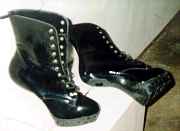
|
| Boots with heels removed, platforms cut off and drilled |
When the excess material has been removed, drill 1/4" holes through the walls of the platforms. The plastic is very tough, so just bang a bunch of holes through it, only making a token effort to keep a pattern. After drilling the holes, I used a coarse wire wheel mounted in a drill to roughen the plastic where the epoxy would contact it. Finally, I used a wood rasp and some sandpaper to smooth and round off the sole where the heels used to be. Note the hole left where the heel was -- it will be filled with resin later. I filled the gaps between the sole and the inner lining of the shoe with a bit of clay to prevent the resin from leaking into the boot.
Since the molds were made directly on the platforms, I used a Dremel handheld grinder to remove about 1/8" of plastic from the very edge of the sole where it meets the upper. This allows a small amount of the epoxy resin to run into the joint and wrap the resin around the top of the platforms just below the uppers. An alumina grinding wheel in the Dremel tool worked surprisingly well -- the heat from the friction melted the plastic away as I moved the tool. Watch out for hot spatters on your hands and face.
Once all the modifications are done, wash the molds with soap and water, and then again with acetone to remove any oil or mold release agents. Clean the surface of the uppers around the sole with acetone as well. Slip the molds over the remains of the platforms and settle them onto the edges of the uppers. Seal the edges of the molds to the uppers with black electrical tape, pressing hard on the tape to ensure a good seal to the patent. Aligning the molds is difficult -- starting at the insole seems to help since there are two good seams close together. Again, take your time -- if you make a mistake, pull off the tape and start over. Use small (1" to 2" strips of tape, and work on alternating sides of the molds to prevent distortion.
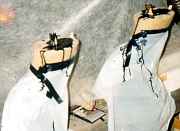
|
| Molds filled with epoxy, boots protected by garbage bags |
First, you need to choose a material for the hoof parts. I went to my local TAP Plastics retail store. TAP is a great place to go browse -- they sell fiberglass cloth, various resins, acrylic shapes, cements, sheet plastic, expanding polyurethane foam, and a billion other things. I told the salesman that I was making some motorcycle body parts (my favorite excuse for wanting plastics) and wanted a castable plastic with excellent strength and impact resistance qualities. The salesman handed me a little brick of two-part epoxy, which I threw as hard as I could at the floor. It bounced.
I bought 2 quarts of the two-part epoxy. I also bought some chopped fiberglass fragments (about 3/8" long), and black pigment to mix into the epoxy for additional impact resistance and color, and a couple of bricks of hard modeling clay. Including a handful of stirring sticks and three mixing cups, the total cost of the epoxy, fiberglass, pigment, and clay was around $45.00.
Now it's time to mix up the epoxy resin. I made up each batch of resin starting with 8 fluid ounces of epoxy resin into which I mixed 1/2 teaspoon of black pigment paste. I stirred the pigment into the resin until it was uniformly colored. Next, I added 8 ounces of the hardener and stirred it well. Finally, I dumped in about 4 tablespoons of chopped fiberglass and stirred it vigorously to separate the glass fibers.
Before pouring the resin into the mold, bang the mixing container on a hard surface a dozen or so times. This will cause some of the trapped air to rise to the surface, preventing air bubbles in the cast. I forgot to do this with mine, and the entire bottom surface of both hooves are pitted with little air bubbles. Lucius (lucius@hurontel.on.ca) suggests using a powerful massage vibrator applied to the container to release the trapped air bubbles.
Pour the resin slowly and evenly into the filling tubes. As you fill the mold, gently tap the sides of the mold and the upper to encourage any air bubbles to rise to the surface. Fill the mold until the level of the material rises to about halfway up both tubes. Very gently pull the filler tube upwards, so that the top surface of the mold slopes upwards, and gently tap the sides of the mold. This should allow any large air bubbles trapped in the tops of the mold to escape. Be very careful doing this -- if you pull the mold off of the boot, the results will be rather messy!
There should be some resin left over (you did make more than you could possibly need, didn't you?), and it should be starting to set into a thick jelly-like consistency. When it is about the consistency of peanut butter, scoop some into the hole in the heel of the boot and pack it into the hole with a flat stick. You will get the best results if you pack it from one side of the hole to the other, rather than filling the hole from the bottom up. Smear the excess resin over the roughened areas left by the rasp, pulling out any glass fibers as you go. Pull a piece of saran wrap over the coated surface to give it a nice smooth, flat finish.
Let the resin cure overnight. It will get very warm as it cures. It's probably not a good idea to poke and prod the curing resin until it has set completely and cooled to room temperature. Once the material has cooled, you may peel off the latex molds. Using a hacksaw or other fine-tooth saw, cut off the cylinders of resin left by the filling and relief tubes.
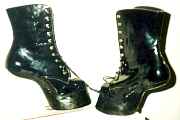
|
| Cast epoxy hooves after removal of molds and excess material |
The next step is to fit the horseshoes. Real farriers have to flatten the horse's hooves so that the shoes lie flat on them. Your hooves are no different. Place both boots upside-down on the padded 2x4's again, and place the horseshoes on the raised ring. Look at how flat they lie against the epoxy hoof. Make a note of any raised area, and sand it flat. I used an electric sander with 80-grit alumina sandpaper, running it in an arc around the raised frog. Take it slow -- it's very easy to take off too much material on one side and ruin the fit. You may find that a large bastard file or rasp is more effective than the sander.
When you have the hooves flattened so the shoes fit without wobbling, place the shoe where you want it (the shoes should face straight forward when the boots are placed in a normal stance). Tape it down to the hoof with electrical tape to prevent it from slipping. Carefully mark the center of each hole in the shoe with an awl. My St. Croix shoes are made with 8 holes, four on each side. You will need one threaded insert and bolt for each hole in the shoes. Threaded inserts are small metal shafts with a coarse thread on the outside, and a threaded hole on the inside. They are designed to be screwed into a pre-drilled hole, and then a bolt is screwed into the threads inside the insert. For my hooves, I used 4-40 pitch inserts, sinking them into 3/16" holes in the epoxy.
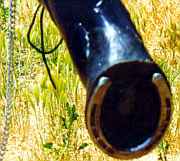
|
| Close-up of the hoof with horseshoe attached to the bottom. |
Once all the inserts are in place, attach the horseshoes to the hooves with 3/4" 4-40 pitch bolts. I found it was easiest to tighten the screws only a few turns at first, leaving some room to move the horseshoe around while aligning each screw. Tighten each screw only a few turns at a time, in a round-robin fashion, until all the bolts are snug. Some of the holes in my horseshoes were too small to allow the bolts to pass freely through them, so I enlarged the holes slightly with a small tungsten carbide cutting tip in the Dremel tool. You may also need to drill out the groove in the shoe in order to let the head of the bolt lie flat against the bottom of the groove.
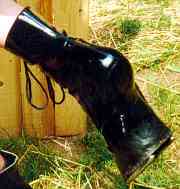
|
| Boots wearing his hooves at the Leather Retreat '99 Pony Camp |
Watch out for differing traction as you move from dirt to grass to pavement. Paved surfaces are actually quite slick with only a thin ring of metal to walk on! Apparently there are different compositions for horseshoes, depending upon where the horses will spend most of their time. For indoor wear, there is a company called Smooth Walker that manufactures a hard rubber horseshoe. I have not personally seen their product, but it could probably be used on these hooves.

|
| The hoof boot with added D-ring detail and hobble chain |
One final detail I'm considering adding is a strap with a locking buckle going over the top of the foot on each boot, allowing the hooves to be secured by the pony's trainer.
Happy Hoofmaking!